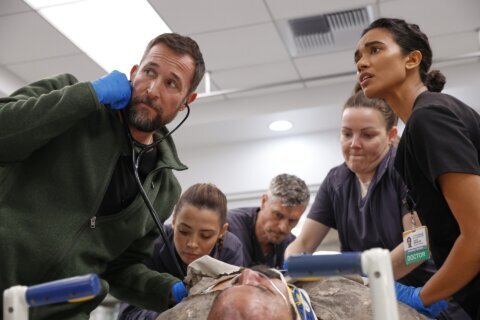Who doesn’t love Paul Rudd?
There may not be a more likable actor in all of Hollywood, watching him rise from “Clueless” (1995), “Wet Hot American Summer” (2001) and “Friends” (2002-2004) to a show-stealer in “Anchorman” (2004), “The 40-Year-Old Virgin” (2005) and “Knocked Up” (2007) to a blockbuster superhero in Marvel’s “Ant-Man” (2015).
Now, he’s popping up in your Netflix queue for a double dose, acting across from himself in the new series “Living with Yourself,” an obvious double entendre with a sci-fi/comedy tone somewhere between “Black Mirror” and “Multiplicity.”
The story follows Miles Elliot (Paul Rudd), who is unhappy with his life as a copywriter at a marketing company. After trying unsuccessfully to have a baby with his interior designer wife Kate (Aisling Bea), he spends the couple’s fertility funds on a mysterious spa treatment that promises DNA enhancement.
Turns out, it’s a shady scheme that gets him replaced by a better, cloned version of himself.
As a twin myself, the concept of dual roles is forever fascinating. The best rendition was arguably Jeremy Irons in “Dead Ringers” (1988), though funnier versions emerged with Eddie Murphy in “The Nutty Professor” (1996) and Mike Myers in “Austin Powers” (1997). More recently, we’ve seen the trick by J.K. Simmons in Starz’s “Counterpart” and Tatiana Maslany in BBC’s “Orphan Black.”
To see Paul Rudd try it is a real treat, creating two distinct personalities. His regular Miles is worn down by life, depressed and mopey, which Rudd elicits with slouching posture, sleepy eyes, messy hair and bookish glasses. On the flip side, his cloned version is joyful, exuberant and innocent, sticking his head out of the car like a dog and boasting the lovable naiveté of Will Ferrell in “Elf” (2003).
Not only is this a neat acting challenge, it’s a fun game for keen critical eyes to guess how the filmmakers designed the physical interactions. When Rudd stands side by side with himself, we think it’s a CGI split screen with an imaginary line he couldn’t cross on set. But when he stands behind himself, it’s a depth-of-field trick using a green screen. At one point, he even smacks himself in the back. Once standard “shot, reaction shot” sequences become a marvel at trying to spot body doubles, especially when the two wrestle with each other during a home invasion.
It’s all directed by the accomplished husband and wife team of Jonathan Dayton and Valerie Faris, who burst onto the scene with their Oscar-winning indie “Little Miss Sunshine” (2006) before casting Paul Dano and Zoe Kazan in “Ruby Sparks” (2012) and Emma Stone and Steve Carell in “Battle of the Sexes” (2017).
If they had handled the script, it might have played wildly different. Instead, the show was conceived and penned by Timothy Greenberg, who won two Emmys and a Peabody as executive producer of Comedy Central’s “The Daily Show with Jon Stewart.” He won another Peabody for Comedy Central’s “Endangered List.”
In “Living With Yourself,” the script starts off with a bang like “Breaking Bad” as Rudd fights through a plastic bag over his face and emerges from being buried alive. Talk about a hook! From there, it’s a little slow to get going, as Act One plays like the Janet Leigh intro of “Psycho” (1960) with a sudden case of stolen money meant for one purpose but put toward another. At least there’s a hilarious cameo by a well-known figure as Rudd enters the spa, but we won’t spoil it here.
As the episodes progress, don’t expect a traditional narrative structure. The storyline routinely doubles back on itself to show the same exact events from a different character’s perspective. We’ll first see something from Miles’ original perspective, then the next episode will show it from the clone’s perspective, then the next episode will show it again from the wife’s perspective. This is not only amusing, it sheds new light on important plot details and character motives.
As we contemplate what is driving each character’s emotions, the title’s double meaning emerges — Miles must live with himself not only physically, but morally for the choices he makes. It’s immoral for him use shared fertility funds for his own purposes. It’s immoral for the clone to try to replace his human self. It’s immoral for the wife to desire the clone more than her real husband.
Put it this way: Imagine having a love triangle with your spouse and yourself. Your romantic rival is you — and not only just you, but a better, more attentive, more thoughtful version of you. As such, the tone is much darker than you might expect from a Paul Rudd project, echoing the social satire of “Invasion of the Body Snatchers” or “The Twilight Zone” more than a laugh-out-loud comedy.
If there’s any flaw, it’s that the series sometimes feels caught in genre limbo, never going as dark as David Cronenberg in “Dead Ringers,” but also never going as light as Harold Ramis in “Multiplicity.” It lives somewhere in the middle, which is perhaps indicative of the postmodern age of anti-heroes that we live in.
The key is to go in with the proper expectations. If you go in expecting a “Black Mirror” episode, you’ll be satisfied and even surprised at the touches of comedy. If you go in expecting a sidesplitting Rudd vehicle, you might find it more awkward than funny.
Still, for an eight-episode series in half-hour installments, it’s a quick binge that’s worth your time to see Rudd shine, twice, with himself.








